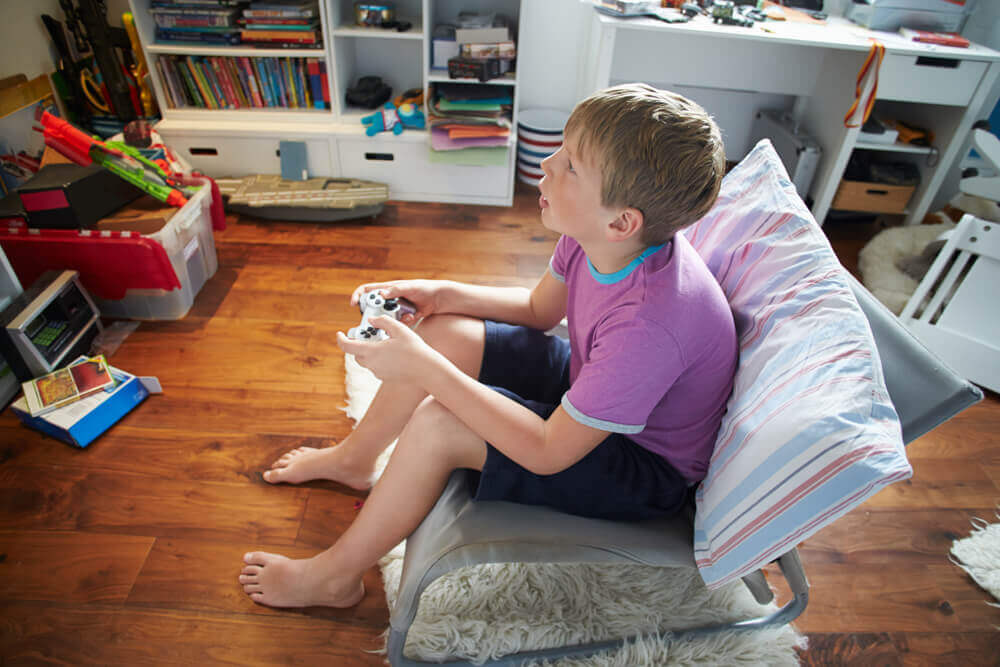Wrist Tendonitis in Children: What You Should Know

Does your child spend hours playing video games? If so, it’s important that you know how this can affect their physical health. Wrist tendonitis in children is something that’s more and more frequent and requires several weeks of recovery in order to avoid relapses.
Advances in technology and prolonged use of screens have led children to suffer from physical conditions that are more prevalent than before. Bad postures sustained over time trigger a series of problems that can condition the quality of life of minors.
We’ll tell you everything you need to know about this condition and how to avoid it. Keep reading!
What causes tendonitis in children?
Tendonitis is the inflammation of the tendons, which is produced by a sustained overload on the same joint or group of joints. It’s a frequent condition among tennis players and golfers, as well as of mothers who hold their babies for several hours a day
However, visits to specialists by children with wrist pain have increased markedly. This seems to be the result of prolonged online gaming sessions with consoles or electronic devices.
In tendinitis, there’s an irritation of the fibers of the tendon that joins the muscle with the bone. If their integrity is affected, it’s called tendinosis. But if the inflammation occurs in the sheath that surrounds them, it’s known as tenosynovitis.
Among the latter, the most well-known is Quervain’s tenosynovitis, which affects the tendons of the thumb muscles and the sheath that surrounds them.
The effects of playing video games for long periods of time

As with any prolonged activity, misaligned posture and a lack of active breaks can lead to serious health problems.
Just as adults are advised to take breaks during their work, children also need to incorporate them after several hours with video games. Above all, because today’s digital games are increasingly engaging and little ones lose track of the time they spend in front of the screen.
Sometimes, infants sit in desks and chairs designed for adults, but other times they sit on the sofa in front of the television. Their concentration on the game leads them to maintain non-ergonomic postures, strain their muscles, and perform repetitive movements with their hands.
Injuries from playing video games vary depending on the type of activity and the controllers used. But overall, wrist tendonitis tops the list of conditions due to sustained joystick use.
The treatment of tendonitis in children
After the evaluation and adequate diagnosis by a doctor, the first measure to adopt is to rest from the activity.
It’s critical that both parents and children understand the importance of stopping the activity that caused the injury until symptoms improve.
In any case, it’s best for rest to be accompanied by physiotherapy treatment. This helps the tissues to heal properly and prevent the injury from reappearing.
The risk of not carrying out an adequate treatment and of not respecting preventive measures is that the injury could last over time and become even more serious.
Treatment begins with reducing the mobility of the joint (with wrist braces or splints), supporting it, and allowing it to rest. This item should be used only during a few moments in the day, mainly when carrying out daily activities.
In addition, the child will need to perform stretching exercises in order for the tendons to maintain their flexibility and functionality. Progressively, activities to strengthen the affected areas are incorporated.
Physical therapists use non-invasive techniques, such as deep transverse (or Cyriax) massage, or invasive techniques, such as acupuncture. A galvanic current is transmitted through the needles, generating changes in the affected tendon tissue. The most common techniques are called EPI (intratissue percutaneous electrolysis) or MEP (percutaneous microelectrolysis) and both offer very good results.
If your child plays video games, keep these precautions in mind
With children, it’s essential to maintain good communication and offer them quality time. If you have a child who’s a gamer, asking them to stop playing their video games probably seems like an almost impossible option. But you can tell them to adopt these tips to take care of their health without leaving aside their activity of interest.
The musculoskeletal alterations that children suffer at an early age can generate long-term sequelae, such as tendon fibrosis or herniated discs, among others. So to prevent wrist tendonitis in children, spinal deviations, muscle aches, and other ailments, keep the following in mind:
- Take active breaks: Every 45 minutes, at most, remind your child to pause, move, and change positions. You can also do some stretching exercises with them to help them keep their muscles flexible.
- Make furniture to suit them: Help your child to get comfortable in a seat with lumbar support and with their feet flat on the floor. Their arms should be supported on the desk to allow their shoulders to be relaxed. The screen should be high enough for the child to keep their gaze horizontal.
- Try a good diet and hydration: A healthy diet, as well as sufficient hydration with water helps to keep the muscles in better condition.
- Encourage recreational physical activities: Playing sports or doing physical activities outdoors offers multiple health benefits for children of any age. Suggest plans of interest to your child so that they agree to go out from time to time.

About technologies in childhood, we can say…
Finally, it’s important to remember that the use of electronic devices by children is the full responsibility of adults. For this reason, their use must be regulated and controlled by parents in order to ensure a healthy consumption of technologies.
Does your child spend hours playing video games? If so, it’s important that you know how this can affect their physical health. Wrist tendonitis in children is something that’s more and more frequent and requires several weeks of recovery in order to avoid relapses.
Advances in technology and prolonged use of screens have led children to suffer from physical conditions that are more prevalent than before. Bad postures sustained over time trigger a series of problems that can condition the quality of life of minors.
We’ll tell you everything you need to know about this condition and how to avoid it. Keep reading!
What causes tendonitis in children?
Tendonitis is the inflammation of the tendons, which is produced by a sustained overload on the same joint or group of joints. It’s a frequent condition among tennis players and golfers, as well as of mothers who hold their babies for several hours a day
However, visits to specialists by children with wrist pain have increased markedly. This seems to be the result of prolonged online gaming sessions with consoles or electronic devices.
In tendinitis, there’s an irritation of the fibers of the tendon that joins the muscle with the bone. If their integrity is affected, it’s called tendinosis. But if the inflammation occurs in the sheath that surrounds them, it’s known as tenosynovitis.
Among the latter, the most well-known is Quervain’s tenosynovitis, which affects the tendons of the thumb muscles and the sheath that surrounds them.
The effects of playing video games for long periods of time

As with any prolonged activity, misaligned posture and a lack of active breaks can lead to serious health problems.
Just as adults are advised to take breaks during their work, children also need to incorporate them after several hours with video games. Above all, because today’s digital games are increasingly engaging and little ones lose track of the time they spend in front of the screen.
Sometimes, infants sit in desks and chairs designed for adults, but other times they sit on the sofa in front of the television. Their concentration on the game leads them to maintain non-ergonomic postures, strain their muscles, and perform repetitive movements with their hands.
Injuries from playing video games vary depending on the type of activity and the controllers used. But overall, wrist tendonitis tops the list of conditions due to sustained joystick use.
The treatment of tendonitis in children
After the evaluation and adequate diagnosis by a doctor, the first measure to adopt is to rest from the activity.
It’s critical that both parents and children understand the importance of stopping the activity that caused the injury until symptoms improve.
In any case, it’s best for rest to be accompanied by physiotherapy treatment. This helps the tissues to heal properly and prevent the injury from reappearing.
The risk of not carrying out an adequate treatment and of not respecting preventive measures is that the injury could last over time and become even more serious.
Treatment begins with reducing the mobility of the joint (with wrist braces or splints), supporting it, and allowing it to rest. This item should be used only during a few moments in the day, mainly when carrying out daily activities.
In addition, the child will need to perform stretching exercises in order for the tendons to maintain their flexibility and functionality. Progressively, activities to strengthen the affected areas are incorporated.
Physical therapists use non-invasive techniques, such as deep transverse (or Cyriax) massage, or invasive techniques, such as acupuncture. A galvanic current is transmitted through the needles, generating changes in the affected tendon tissue. The most common techniques are called EPI (intratissue percutaneous electrolysis) or MEP (percutaneous microelectrolysis) and both offer very good results.
If your child plays video games, keep these precautions in mind
With children, it’s essential to maintain good communication and offer them quality time. If you have a child who’s a gamer, asking them to stop playing their video games probably seems like an almost impossible option. But you can tell them to adopt these tips to take care of their health without leaving aside their activity of interest.
The musculoskeletal alterations that children suffer at an early age can generate long-term sequelae, such as tendon fibrosis or herniated discs, among others. So to prevent wrist tendonitis in children, spinal deviations, muscle aches, and other ailments, keep the following in mind:
- Take active breaks: Every 45 minutes, at most, remind your child to pause, move, and change positions. You can also do some stretching exercises with them to help them keep their muscles flexible.
- Make furniture to suit them: Help your child to get comfortable in a seat with lumbar support and with their feet flat on the floor. Their arms should be supported on the desk to allow their shoulders to be relaxed. The screen should be high enough for the child to keep their gaze horizontal.
- Try a good diet and hydration: A healthy diet, as well as sufficient hydration with water helps to keep the muscles in better condition.
- Encourage recreational physical activities: Playing sports or doing physical activities outdoors offers multiple health benefits for children of any age. Suggest plans of interest to your child so that they agree to go out from time to time.

About technologies in childhood, we can say…
Finally, it’s important to remember that the use of electronic devices by children is the full responsibility of adults. For this reason, their use must be regulated and controlled by parents in order to ensure a healthy consumption of technologies.
All cited sources were thoroughly reviewed by our team to ensure their quality, reliability, currency, and validity. The bibliography of this article was considered reliable and of academic or scientific accuracy.
- MedlinePlus en español [Internet]. Bethesda (MD): Biblioteca Nacional de Medicina (EE. UU.). Tenosinovitis; [actualizado 05 octubre 2021; revisado 25 jul. 2020; consulta 10 oct. 2021]. Disponible en: https://medlineplus.gov/spanish/ency/article/001242.htm
- Jalink, Maarten B., et al. Nintendo related injuries and other problems. Bmj 349 (2014).
- Benegas E, et al. Frecuencia de Tendinitis de De Quervain en estudiantes de medicina y su relación con el uso de smartphones. Rev. Par. Reumatol. 2019;5(1):03-07. Disponible en: https://core.ac.uk/download/pdf/324103041.pdf
- Bueno, Antonio Jurado, and Iván Medina Porqueres. Tendón: valoración y tratamiento en fisioterapia. Paidotribo, 2011.
- Martínez Pizarro, Sandra. Electrólisis percutánea intratisular en el tratamiento del dolor. Revista Cubana de Medicina Militar 2020, 49.2.
- d’Almeida, Santiago Marcelo, Rodrigo Marcel Valentim da Silva, and Oscar Ariel Ronzio. Nivel de satisfacción sobre la seguridad y complicaciones a cuatro años de la introducción de la técnica Microelectrólisis Percutánea (MEP®) Sport como práctica fisioterapéutica. Fisioterapia e Pesquisa 26 (2019): 190-195.
This text is provided for informational purposes only and does not replace consultation with a professional. If in doubt, consult your specialist.








